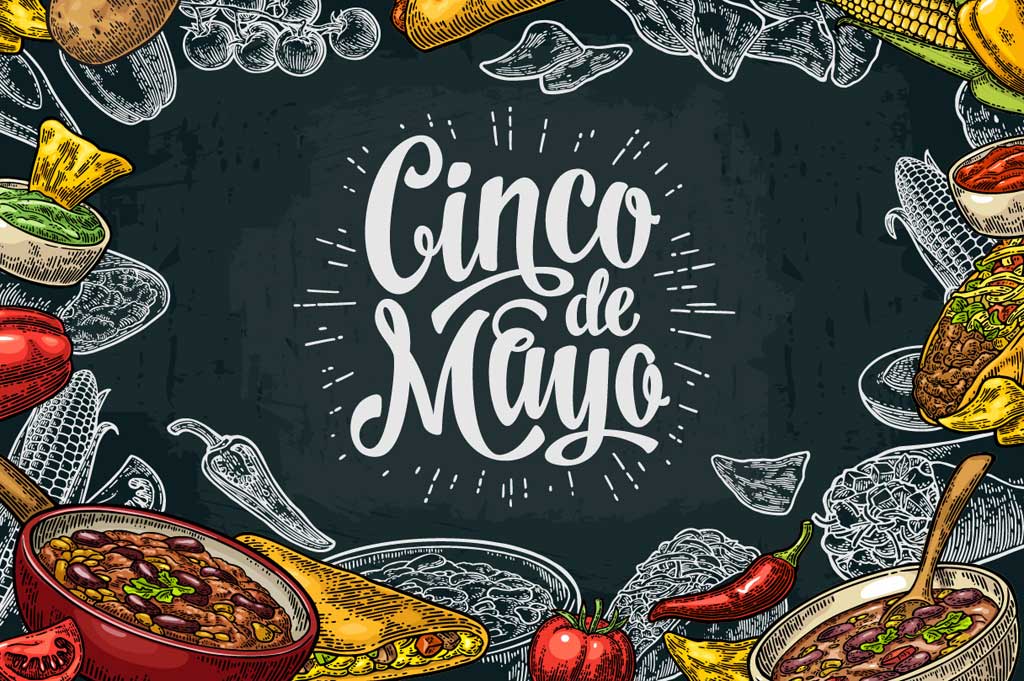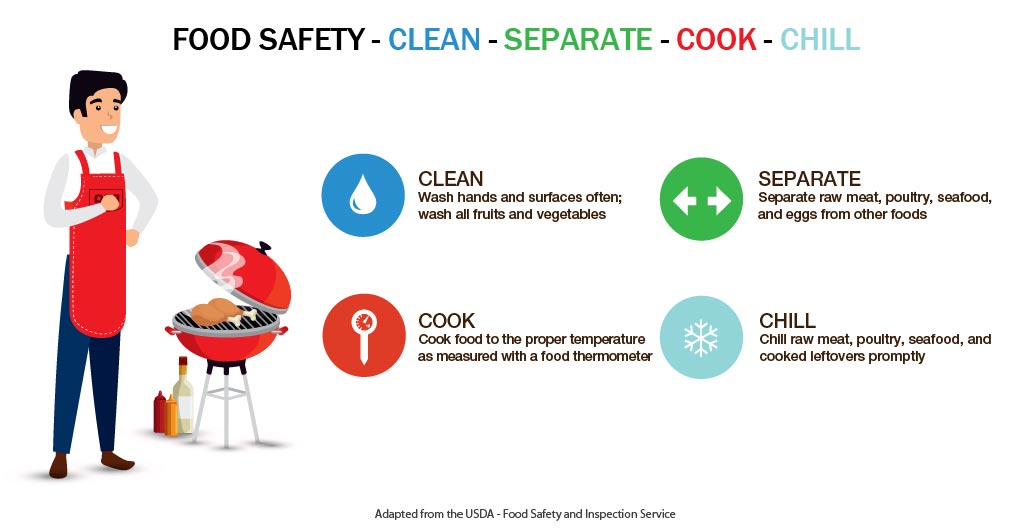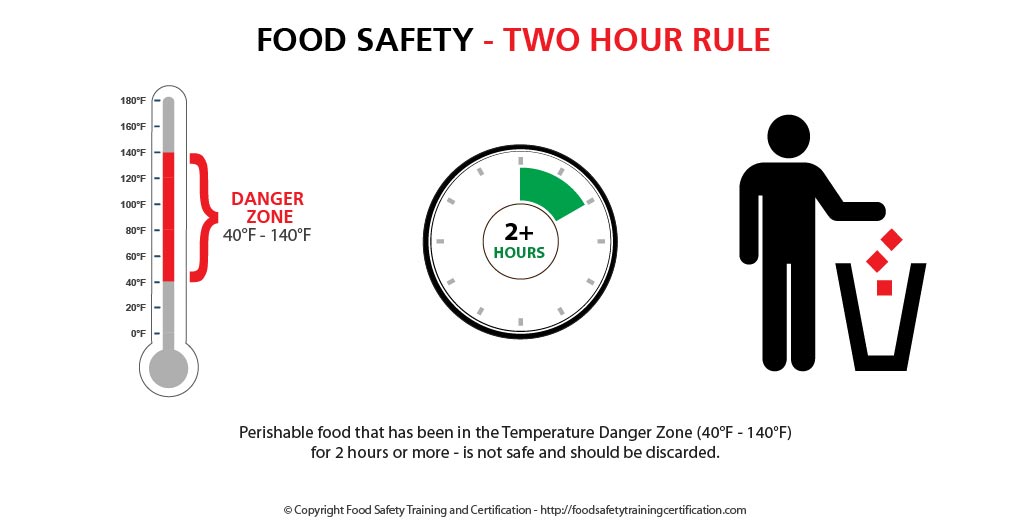Cinco de Mayo (May 5th) has become increasingly popular and is celebrated by hosting large parties, cooking delicious traditional Mexican foods, and drinking margaritas. But, to protect your party guests from a foodborne illness, follow important food safety procedures and principles.
The annual remembrance of the Mexican army’s 1862 victory over France at the Battle of Puebla during the Franco-Mexican War has become a major marketing opportunity for everything from tortilla chips to margarita mix.



Dangers of Leaving Food Out
A popular way to celebrate a party occasion is to cook a lot of food and invite friends and family. However, this type of food service – where foods are left out for long periods – leaves the door open for uninvited guests – bacteria that cause foodborne illness. Festive times for giving and sharing should not include sharing foodborne illness.
- Learn about proper hygiene, cross contamination, cold and hot food safety, foodborne pathogens, and best practices to prevent foodborne illness.
- Food Manager Training & ANSI Certification - $99.00
- Food Handler Training - only $7.00!
- HACCP Training: 16hr/4hr/1hr
- Food Allergy Training - $15.00
- Enter Promo "train10off" at Checkout
Among the most popular Cinco de Mayo dishes are chimichangas, fajitas and tacos. These dishes usually contain shredded beef, chicken and pork cooked in delicious sauces and spices.
Salsa, guacamole, shredded meat and poultry are all potential vectors for foodborne pathogens such as E. coli, Salmonella, and Listeria.



Cinco de Mayo Party Food Safety Tips
Make sure your Cinco de Mayo gatherings are memorable for all the right reasons! Follow simple but important food safety tips to avoid food poisoning:



- Keep hands, kitchen, dishes and utensils clean. Wash your hands constantly during preparation, serving and cleanup. Keep your kitchen, dishes and utensils clean. Be sure your serving dishes are clean.
- Avoid Cross-Contamination. Separate raw meats from other foods to avoid cross-contamination. Also, do not serve food on plates that previously held raw meat or poultry.
- Keep perishable foods refrigerated. Keep all perishable foods chilled until serving time. These include finger sandwiches, cheese platters, fruit or tossed salads, cold pasta dishes with meat, poultry, or seafood, and cream pies or cakes with whipped-cream and cream-cheese frostings.
- Keep hot food hot and cold food cold.
- Hot foods should be held at 140°F or warmer. On the buffet table, keep hot foods hot with chafing dishes, warming trays or slow cookers. Keep the covers on the hot food dishes to keep the heat inside the dish.
- Cold food should be held at 40°F or colder. Keep foods cold by nesting dishes in bowls of ice. Otherwise, use smaller serving platters and replace them often.



- Use a Food thermometer. Public health officials recommend using a food thermometer to make sure foods are cooked to a high enough temperature to kill pathogens and bacteria. Those temperatures are:
- 145°F for whole beef, veal, fish, lamb, fresh pork and ham — allowing the meat to cool for 3 minutes before carving or consuming;
- 160°F for ground beef, veal, pork and lamb, and for egg dishes.
- 165°F for all poultry, including ground chicken and ground turkey, and stuffing, leftovers and casseroles.
- Safe serving tips.
- When serving foods on a buffet table, serve them in several small dishes or platters rather than on huge platters.
- Keep the rest of the hot food in your oven (set at 200 to 250°F) or cold food in the refrigerator until serving. This way, the foods will be kept at safe temperatures for a longer period of time.
- When the small platters are empty, replace them with clean dishes rather than add fresh food to a dish that already had food in it.
- Leftover food safety – Use the 2-hour rule.
- Bacteria will multiply if you let foods sit out too long. Don’t leave perishable goodies out of the fridge for more than two hours (1 hour in temperatures above 90°F).
- Refrigerate or freeze leftovers within two hours of serving. If the leftover foods were on your buffet longer than two hours, throw them out.
- Eat your leftovers within three to four days. Use your freezer for longer storage. Reheat leftovers to 165°F.



- Clean up after your party. Use soap and water to wash the countertops, tables and the refrigerator door handle (one of the dirtiest spots in a busy kitchen). After washing and rinsing off the suds, follow up with a sanitizing solution of one teaspoon of bleach to one quart of water. Spray on the clean surfaces and air-dry.
Additional Resources – Cooking for Groups Food Safety
- Seasonal: Holiday or Party Buffets (FSIS) — foodsafety.gov
- Cooking for Groups FSIS Image Library – Brochure graphics are offered here in a high resolution format (EPS) and low resolution format (JPG). Most are available in color or black and white (B/W).
- 7 Food Safety Steps for Successful Community Meals | PDF
- Cooking for Groups: A Volunteer’s Guide to Food Safety (USDA)
Prepare and serve food safely for large groups such as family reunions, church dinners, and community gatherings. - “No-Show” Guests Jeopardize Food (USDA)
If a meal must be delayed or cancelled, food must be handled “just right” to remain safe. - Holiday or Party Buffets (USDA)
When foods are left out for long periods, you may have uninvited guests — bacteria that cause foodborne illness.






